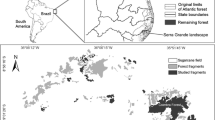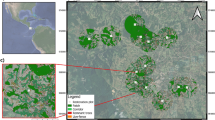Abstract
In landscapes dominated by late-successional plant communities, early-successional species may lead a tenuous existence, persisting only as fugitives or relying on refuges in marginal habitats to provide a persistent seed source. The objective of this study was to relate fine-scale distributions of early-successional tree species in hemlock-hardwood forests of northern Wisconsin, USA to potential landscape persistence strategies. A special emphasis was placed on eastern white pine (Pinus strobus), a restoration priority in the region. Witness tree data from nineteenth century US Public Land Survey records (encompassing 40,610 km2 and 106,790 trees) were used with modern environmental data to relate species distributions to habitat characteristics. Early-successional tree species had strong positive associations with marginal habitats such as inclusions of sandy soil and margins of lakes, wetlands, and rivers. Marginal habitats occupied ~44 % of the landscape, which may help account for the abundance of early-successional species in our study area relative to other hemlock-hardwood forests. Populations of early-successional species in marginal habitats could also have provided important seed sources for the upland mesic landscape matrix, as >70 % of the landscape was within 200 m of these habitats. The degree to which early-successional species were limited to marginal habitats largely followed predictions based on species life-history characteristics, except that white pine was more common than expected in upland mesic habitats. These findings illustrate the potential importance of landscape heterogeneity for persistence of early-successional species in late-successional forest landscapes and provide baseline information on habitat associations and landscape dynamics that will be useful in restoration efforts.



Similar content being viewed by others
References
Abrams MD (2001) Eastern white pine versatility in the presettlement forest. Bioscience 51:967–979
Abrams MD, Orwig DA (1996) A 300-Year history of disturbance and canopy recruitment for co-occurring white pine and hemlock on the Allegheny Plateau, USA. J Ecol 84:353–363
Abrams MD, Ruffner CM (1995) Physiographic analysis of witness-tree distribution (1765–1798) and present forest cover through north central Pennsylvania. Can J For Res 25:659–668
Ahlgren CE (1976) Regeneration of red pine and white pine following wildfire and logging. J For 74:135–140
Bergeron Y (1991) The influence of island and mainland lakeshore landscapes on boreal forest fire regimes. Ecology 72:1980–1992
Bourdo EA (1956) A review of the General Land Office survey and of its use in quantitative studies of former forests. Ecology 37:754–768
Burns RM, Honkala BH (1990) Silvics of North America: 1. Conifers; 2. Hardwoods. Agric Handbook 654:13–63
Canham CD, Loucks OL (1984) Catastrophic windthrow in the presettlement forests of Wisconsin. Ecology 65:803–809
Clark JS, Royall PD (1996) Local and regional sediment charcoal evidence for fire regimes in presettlement north-eastern North America. J Ecol 84:365–382
Cleland CE (1983) Indians in a changing environment. In: Flader SL (ed) The Great Lakes forest: an environmental and social history. University of Minnesota Press, Minneapolis, pp 83–95
Cogbill CV, Burk J, Motzkin G (2002) The forests of presettlement New England, USA: spatial and compositional patterns based on town proprietor surveys. J Biogeogr 29:1279–1304
Curtis JT (1959) The vegetation of Wisconsin. University of Wisconsin Press, Madison
Davis MB, Calcote RR, Sugita S, Takahara H (1998) Patchy invasion and the origin of a hemlock-hardwoods forest mosaic. Ecology 79:2641–2659
Drobyshev I, Goebel PC, Hix DM, Corace RG, Semko-Duncan ME (2008) Pre-and post-European settlement fire history of red pine dominated forest ecosystems of Seney National Wildlife Refuge, Upper Michigan. Can J For Res 38:2497–2514
Dunn CP, Guntenspergen GR, Dorney JR (1983) Catastrophic wind disturbance in an old-growth hemlock-hardwood forest, Wisconsin. Can J Bot 61:211–217
Engstrom FB, Mann DH (1991) Fire ecology of red pine (Pinus resinosa) in northern Vermont, USA. Can J For Res 21:882–889
Eriksson O (1996) Regional dynamics of plants: a review of evidence for remnant, source-sink and metapopulations. Oikos 77:248–258
Fahey RT (2011) Establishment and persistence of early successional pine species in late-successional landscapes of the Great Lakes region. Ph.D. Dissertation, University of Wisconsin-Madison
Foster DR (1988) Disturbance history, community organization and vegetation dynamics of the old-growth Pisgah Forest, south-western New Hampshire. J Ecol 76:105–134
Frelich LE (2002) Forest dynamics and disturbance regimes: studies from temperate evergreen-deciduous forests. Cambridge University Press, Cambridge
Frelich LE, Lorimer CG (1991) Natural disturbance regimes in hemlock-hardwood forests of the Upper Great Lakes region. Ecol Monogr 61:145–164
Godman RM, Mattson GA (1976) Seed crops and regeneration of 19 species in northeastern Wisconsin. USDA Forest Service, Research Paper NC-123. North Central Forest Experiment Station, St. Paul. 5 p
Goebel PC, Palik BJ, Pregitzer KS (2003) Plant diversity contributions of riparian areas in watersheds of the northern Lake States, USA. Ecol Appl 13:1595–1609
Graham SA (1941) Climax forests of the Upper Peninsula of Michigan. Ecology 22:355–362
Hough AF, Forbes RD (1943) The ecology and silvics of forests in the high plateaus of Pennsylvania. Ecol Monogr 13:299–320
Hubbell SP (2001) The unified neutral theory of biodiversity and biogeography. Princeton University Press, Princeton
Hupp CR, Osterkamp WR (1996) Riparian vegetation and fluvial geomorphic processes. Geomorphology 14:277–295
Iverson LR, Dale ME, Scott CT, Prasad A (1997) A GIS-derived integrated moisture index to predict forest composition and productivity of Ohio forests (USA). Landscape Ecol 12:331–348
Jenness J (2005) Topographic Position Index (tpi_jen. avx) extension for ArcView 3. x. URL: http://wwwjennessentcom/arcview/tpihtm. Jenness Enterprises
Keys JE, Carpenter C, Hooks S, Koenig F, McNab WH, Russell W, Smith ML (1995) Ecological units of the eastern United States—first approximation. US Department of Agriculture, Forest Service, Missoula
Kobe RK, Pacala SW, Silander JA Jr, Canham CD (1995) Juvenile tree survivorship as a component of shade tolerance. Ecol Appl 5:517–532
Kotar J, Kovatch JA, Burger TL (2002) A guide to forest communities and habitat types of northern Wisconsin. Department of Forest Ecology and Management, University of Wisconsin-Madison, Madison
Liu F, Mladenoff DJ, Keuler NS, Schulte Moore L (2011) Broadscale variability in tree data of the historical Public Land Survey and its consequences for ecological studies. Ecol Monogr 81:259–275
Loehle C (2000) Strategy space and the disturbance spectrum: a life-history model for tree species coexistence. Am Nat 156:14–33
Lorimer CG (1977) The presettlement forest and natural disturbance cycle of northeastern Maine. Ecology 58:139–148
Lorimer CG (2008) Eastern white pine abundance in 19th century forests: a reexamination of evidence from land surveys and lumber statistics. J For 106:253–260
Lorimer CG, White AS (2003) Scale and frequency of natural disturbances in the northeastern US: implications for early-successional forest habitats and regional age distributions. For Ecol Manage 185:41–64
Manies KL, Mladenoff DJ, Nordheim EV (2001) Assessing large-scale surveyor variability in the historic forest data of the original US Public Land Survey. Can J For Res 31:1719–1730
Marks PL (1983) On the origin of the field plants of the northeastern United States. Am Nat 122:210–228
Marks PL, Gardescu S (1992) Vegetation of the central Finger Lakes region of New York in the 1790s. New York State Museum Bull 484:1–33
McCune B (2006) Non-parametric habitat models with automatic interactions. J Veg Sci 17:819–830
McCune B (2009) Nonparametric multiplicative regression for habitat modeling. http://www.pcord.com/NPMRintro.pdf
McCune B, Keon D (2002) Equations for potential annual direct incident radiation and heat load. J Veg Sci 13:603–606
McCune B, Mefford MJ (2004) HyperNiche. Nonparametric multiplicative habitat modeling. MjM Software, Gleneden Beach. Version 1
McIntosh RP (1962) The forest cover of the Catskill Mountain region, New York, as indicated by land survey records. Am Midl Nat 68:409–423
Naiman RJ, Decamps H, Pollock M (1993) The role of riparian corridors in maintaining regional biodiversity. Ecol Appl 3:209–212
NRCS (2007) Natural Resources Conservation Service (NRCS), United States Department of Agriculture. Soil Survey Geographic (SSURGO) Database
Oliver T, Roy DB, Hill JK, Brereton T, Thomas CD (2010) Heterogeneous landscapes promote population stability. Ecol Lett 13:473–484
Palik B, Streblow D, Egeland L, Buech R (2007) Landscape variation of seasonal pool plant communities in forests of northern Minnesota, USA. Wetlands 27:12–23
Pickett STA, White PS (1985) The ecology of natural disturbance and patch dynamics. Academic, New York
Platt WJ (1975) The colonization and formation of equilibrium plant species associations on badger disturbances in a tall-grass prairie. Ecol Monogr 45:285–305
Platt WJ, Connell JH (2003) Natural disturbances and directional replacement of species. Ecol Monogr 73:507–522
Rhemtulla JM, Mladenoff DJ, Clayton MK (2009) Legacies of historical land use on regional forest composition and structure in Wisconsin, USA (mid-1800s-1930s-2000s). Ecol Appl 19:1061–1078
SAS-Institute (2005) SAS v. 9.2. SAS Institute Inc., Durham
Schulte LA, Mladenoff DJ (2005) Severe wind and fire regimes in northern forests: historical variability at the regional scale. Ecology 86:431–445
Spalding VM, Fernow BE (1899) The white pine (Pinus strobus Linnaeus). USDA Division of Forestry Bulletin, Washington
Stearns F (1951) The composition of the sugar maple-hemlock-yellow birch association in northern Wisconsin. Ecology 32:245–265
Tilman D (1994) Competition and biodiversity in spatially structured habitats. Ecology 75:2–16
USGS (2011) US Geological Survey, National Hydrography Dataset. http://nhd.usgs.gov/
Wang YC (2007) Spatial patterns and vegetation-site relationships of the presettlement forests in western New York, USA. J Biogeogr 34:500–513
Whitney GG (1986) Relation of Michigan’s presettlement pine forests to substrate and disturbance history. Ecology 67:1548–1559
Whitney GG (1996) From coastal wilderness to fruited plain: a history of environmental change in temperate North America, 1500 to the present. Cambridge University Press, Cambridge
Whitney GG, DeCant JP (2003) Physical and historical determinants of the pre-and post-settlement forests of northwestern Pennsylvania. Can J For Res 33:1683–1697
WiDNR (2010) Wisconsin Department of Natural Resources. Geospatial Data Library. http://dnrwigov/maps/gis/dataoverviewhtml
WSCO (2010) Wisconsin Climate History, Wisconsin State Climatology Office, Madison. www.aos.wisc.edu/~sco
Acknowledgments
Financial support for this research was provided by the McIntire-Stennis Cooperative Forestry Research Program, Connor Hardwood Research Fund, Garden Club of America Ecological Restoration Fellowship program, and a grant from the Huron Mountain Wildlife Foundation. We are grateful to Phil Townsend, James Bockheim, Glen Stanosz and two anonymous reviewers for their comments on earlier versions of the manuscript.
Author information
Authors and Affiliations
Corresponding author
Rights and permissions
About this article
Cite this article
Fahey, R.T., Lorimer, C.G. & Mladenoff, D.J. Habitat heterogeneity and life-history traits influence presettlement distributions of early-successional tree species in a late-successional, hemlock-hardwood landscape. Landscape Ecol 27, 999–1013 (2012). https://doi.org/10.1007/s10980-012-9754-z
Received:
Accepted:
Published:
Issue Date:
DOI: https://doi.org/10.1007/s10980-012-9754-z




